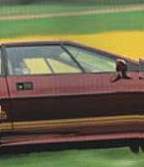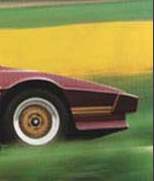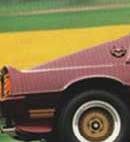 |
|||||||
 |
|||||||
 |
|||||||
|
MODELES ESPRIT |
S 4 | S 4 S | SP 300 | SP 350 |
|
Prix en Francs T.T.C. |
535 000 | 545 000 | 655 000 | 665 000 |
|
MOTEUR |
||||
| Type |
4 cylindres en ligne | |||
| Emplacement |
Monté longitudinalement en position centrale arrière | |||
| Distribution |
16 soupapes à injection | |||
| Alimentation |
turbocompresseur
|
turbocompresseur
hybride | ||
| Cylindrée |
2174 cm³ | |||
| Puissance administrative |
10 CV | |||
| Puissance maxi ( ch DIN ) |
264 à 6500 tr/mn |
302 à 6 400 tr/mn | ||
| Couple maxi (Nm) |
354 à 3 900 tr/mn |
389 à 4400 tr/mn | ||
| TRANSMISSION |
Par embrayage hydraulique et boîte mécanique à 5 vitesses aux roues arrière |
Par embrayage hydraulique et boite mécanique à 5 vitesse et différentiel à glissement limité Lotus aux roues arrière | ||
| CHASSIS |
Poutre centrale rigide en tôle
acier | |||
| SUSPENSION |
Avant: roues indépendantes avec triangle
stabilisateur supérieur et levier inférieur.
| |||
| FREINAGE |
Double circuit hydraulique.
| |||
| JANTES |
alliage d'aluminium | |||
| DIMENSIONS & CAPACITE |
x | |||
| Longueur / largeur / hauteur (mm) |
4 369 x 1 867 x 1 150 |
4 391 x 1 900 x 1 164 | ||
| Réservoir essence (litre) |
73 | |||
| Poids à vide selon constructeur (kg) |
1 339 |
1 300 | ||
| Rapport Poids/Puissance |
5,4 |
4,2 | ||
| PERFORMANCES & CONSOMMATION |
x | |||
| Vitesse maxi (km/h) |
257 |
258 |
270 |
281 |
| Accélération de 0 à 100 km/h (s) |
5 |
4,8 | ||
| Consommation
(L/100km) 90 km/h 120km/h en ville |
7,8 / 9,5 / 15,8 |
8,2 / 10,3 / 15 | ||
|
MODELES |
ESPRIT GT3 | ESPRIT V8 | ESPRIT V8 GT |
|
Prix en Francs T.T.C. |
399 000 | 535 000 | 415 000 |
|
MOTEUR |
x | ||
| Type |
4 cylindres en ligne |
Lotus à 90° |
3.5litre twin-turbo |
| Emplacement |
Central arrière longitudinal |
||
| Distribution |
2 ACT/4 Soupapes par cylindre |
4 ACT/4 Soupapes par cylindre |
|
| Entraînement |
Courroies crantées |
||
| Alimentation |
Turbo Garrett |
Double Turbo Garrett |
|
| Cylindrée |
1974 cm³ |
3506 cm³ |
|
| Puissance administrative |
18 cv |
27cv |
ND |
| Puissance maxi (kw) |
179 à 6250 tr/mn |
260 à 6 500 tr/mn | |
| Couple maxi (Nm) |
294 à 3 750 tr/mn |
400 à 4250 tr/mn | |
| TRANSMISSION |
Roues arrières motrices | ||
| BOITE DE VITESSE |
Mécanique à 5 rapports | ||
| EMBRAYAGE |
Monodisque à sec à commande hydraulique |
Double disque à sec à comande hydraulique | |
| CHASSIS |
Poutre centrale rigide en
acier | ||
| CARROSSERIE |
2 places constituées de deux demi-coque en matériaux composites. | ||
| SUSPENSION |
Amortisseurs téléscopiques et ressorts
hélicoïdaux | ||
| FREINAGE |
Double circuit hydraulique et
disques ventilés | ||
| JANTES |
alliage d'aluminium | ||
| DIMENSIONS & CAPACITE |
x | ||
| Longueur / largeur / hauteur (mm) |
4 369 x 1 867 x 1 150 |
4 369 x 1 883 x 1 150 | |
| Réservoir essence (litre) |
73 | ||
| Poids à vide selon constructeur (kg) |
1 304 |
1 380 |
1 340 |
| Rapport Poids/Puissance |
5,4 |
4,2 |
|
| PERFORMANCES & CONSOMMATION |
x | ||
| Vitesse maxi (km/h) |
263 |
282 |
|
| Accélération de 0 à 100 km/h (s) |
5,2 |
4,9 |
|
| Consommation (l/100km) cycle combiné |
12,5 |
13,3 |
13,3 |
REMPLACEMENT D'UNE COURROIE DE DISTRIBUTION SUR UNE ESPRIT TURBO DE 1984
Par Jim Seippel
(from Lotus email list - March 9, 1998)
Je n'avais pas le manuel technique de ma lotus quand je décidais de changer ma courroie de distribution. le travail m'a pris environ 4 heures, mais j'aurais pu le faire en 2 heures et demi. J'ai rencontré quelques problèmes qui m'on causé quelques soucis. Je vais vous expliquer ma manière de faire au cas ou vous voudriez faire de même . J'ai écrit cette procédure 2 jours après avoir effectué le travail donc il peut y avoir quelques erreurs ou commissions. J'aurais aimé avoir le manuel, mais pour la commande il y avais trop de jours d'attente.
J'avais trouvé une chèvre donc je pouvais changer ma courroie de transmission. Mais on peut toujours utiliser des support fixe (chandelles) pour opérer. Avant de commencer assurez vous que vous avez en votre possession un marqueur blanc et du fil de fer de blocage. L'utilité de ces des objet apparaîtra utile plus tard. Ce qui suit concerne une ESPRIT 84 TURBO , donc pour les autres models il y aura peut être des modifications a prévoir.
=============================================
1. Vidanger le liquide de refroidissement (purge sur la droite du radiateur).
2. Depuis le dessus de l'auto et par l'intérieur du compartiment, enlever le cache culbuteur, la boite a air (attacher la avec deux vis de 6mm a l'extérieur du compartiment) et le vase d'expansion (monter le pour bien finir de vidanger le liquide de refroidissement).
3. Dévisser l'écrou de serrage de l'alternateur, puis dévisser la vis de blocage , enlever l'axe de l'alternateur, vous pouvez ensuite basculer l'alternateur.
4. Dévisser le collier autour de la durite, dévisser le nez du calorstat - enlever la durite puis deviser les deux vis de 8mm qui fixent le calorstat. Tourner doucement la durite et récupérer le calorstat dans votre main et le ranger précieusement.
5. enlever la durite qui part du cache culbuteur vers l'extérieur.
6. enlever maintenant le cache culbuteurs.
7. Pour bloquer le vilebrequin il vous faut une barre ou un clé de 19, trouver un endroit pour la bloquer sachant que le serrage se fait dans le sens des aiguilles d'une montre , éviter de trop abîmer le châssis. maintenant fait e tourner le démarreur a l'aide de la clé de contact. Le démarreur tournera jusqu'a bloquer la poulie du vilebrequin a l'aide de la clé de 19.
8. Par dessous la voiture, tourner la poulie du vilebrequin en utilisant la clé. Vous devez mettre en face les deux repère l'un sur la poulie l'autre sur le bloc moteur. Vous pouvez utilisez un miroir ou mieux vos ongle pour pouvoir sentir la marque sur la poulie. Une fois effectuer cette opération vous êtes au point mort haut.
9. Depuis le dessus du compartiment moteur il faut vérifier que vos 2 arbres a cames sont bien en face du repère, vérifier bien a la main , il doit aussi y avoir une marque sur la poulie de la pompe a huile . si vous ne voyez pas toute les marques, retourner sous la voiture et faite faire une rotation suplementaire a la poulie de vilebrequin . retourner et reverifier toute vos repères. Dans mon cas, la poulie coté admission avais 3 repères - 2 repères bleues approximativement a 180 degrés et un repère rouge distant de 90 degrés des repères bleus. la poulie cote échappement n'avais pas d'autres repères. Si vos repères sont tous trouvés, remettez un point de crayon blanc pour facilitez leur repérages ultérieur. Si vous ne retrouvez pas les repères d'origines comme sur mon moteur, respectez bien l'alignement entre la poulie du vilebrequin et celle du bloque moteur marquant ainsi le point mort haut (repère du dessus) marquer a l'aide du crayon blanc les dents de toute les poulies . Mettez aussi une repère blanc sur la pignonerie du distributeur. Une fois tous ces repères effectué vous n'avez plus le soucis de casser une soupape au redémarrage.
10. enlever les vis de fixation de la poulie d'entraînement du vilebrequin, attention de ne pas faire tourner le vilebrequin au desserrage. j'ai utiliser un tournevis pour bien bloquer la poulie. Cette manipulation sera difficile si vous avez très souvent tourner le vilebrequin pour trouver les repères .
11.si présent desserrer maintenant la pompe a air ainsi que le compresseur d'air conditionné ( 3 vis ) .
12. Vous pouvez enlever maintenant la poulie du vilebrequin en douceur
13. Enlever la pièce triangulaire qui est fixé entre la vis basse de l'alternateur et celle du dessus du tendeur de la courroie. Il y a une 3eme vis qui retient cette pièces mais vous pouvez l'enlever par dessus.
14.enelever toute les durites qui sont encore sur le moteur.
15. Enlever le tendeur. - enlever le rouleau en devissant dans le sens des aiguilles d'une montre .Vous pouvez maintenant enlever les vis de fixation du tendeur lui-meme. verifier mais il fois y avoir un trou pour bloque le tendeur afin de faciliter son démontage. Compress the tensioner with your hands and insert a large paper clip into the lock hole on the tensioner to hold the tensioner compressed. The paperclip should engage a groove on the tensioner plunger and keep the tensioner compressed. Now remove lower attaching bolt and then remove the tensioner. This sounds easier than it actually is since the tensioner is still mostly too big. With patience, the tensioner will fall out into your hands.
16. Now remove the timing belt by pulling it to the front of the engine and snaking it around the water pump and hoses that are still attached to the engine..
17. Put the new timing belt on the engine by snaking it around the obstacles on the engine using the reverse of the moves that you used to remove it. Be careful not to kink the belt or otherwise damage it. Slide the belt onto the intake pulley under the "L" shaped safety bracket and then slide the belt over the exhaust pulley. From the bottom - keep the belt tight between the exhaust cam pulley and the crankshaft pulley and slide the belt over the crankshaft pulley. The Belt should not have any slack between the exhaust pulley and the crankshaft pulley.
18. Now get your significant other or a sober friend to sit in the trunk and watch the marks for you. Put the belt over the distributor pulley and make sure that there is no slack between the intake and the distributor pulley. You should have the belt installed at this point with all of the slack between the distributor pulley and the crankshaft pulley and all of the marks should line up. You should slide the crank belt pulley back on the crankshaft to check the crank timing mark.
19 Now take the tensioner and loosen the adjustment until the adjustment screw has only one or two threads engaged. Use the lock wire and loop a piece around the edge of the fork that supports the idler pulley. The wire goes between the pulley and the fork. String the lock wire around the boss that the lower alternator adjusting bracket bolt screws into and tighten the lock wire until the tensioner is completely compressed. If you do not do this, the tensioner will not be able to be reinstalled since it will be expanded and will be bigger than it's mounting location. An alternative procedure is to use a large paperclip inserted into the small hole next to the upper mounting bolt hole. The paperclip must engage the groove on the tensioner plunger. Either method to keep the tensioner compressed is acceptable. I like the lockwire method because it is possible to compress the tensioner more.
20. Now reinstall the tensioner and replace the two screws by sliding them into place and tightening them a turn or two. Check all four timing marks again by sliding the crank pulley back in the crankshaft and checking the position of the crankshaft. Now ask your helper to check the other marks. Cut the lock wire and remove it taking care not to damage the new timing belt.
21. Remove the crank pulley and tighten the lower and upper tensioner attaching bolts. Then tighten the tensioner adjustment using a 13mm open end wrench. You can check the free play in the tensioner by deflecting the belt between the exhaust cam and the crankshaft. I adjust the tensioner until there is about 1/8th inch of free play in the tensioner checked between the pulley bracket and the tensioner body. Tighten the locknut on the tensioner adjustment using a 15/16 inch box end wrench. I happened to have a cheap wrench in my toolbox that was shorter than the normal wrench and fit perfectly.
22. Now reinstall the crankshaft pulley and bolt and turn the engine over by hand 2 full revolutions until the crankshaft pulley timing mark aligns. Ask you helper to check the timing marks on the cam pulleys and on the distributor pulley. If the marks align perfectly, check then yourself. If you don't check them yourself and they didn't line up and you bend something, you might wind up in divorce court. If all of the marks line up, pat yourself on the back, you are close to being finished. If they don't line up, say a few curse words and then remove the tensioner and position the marks correctly, then go back to step 19.
23. Remove the crank pulley and attach the triangle bracket by sliding it over the alternator pivot bolt and start the lower bolt that attaches the triangle bracket and lower alternator adjustment bracket to the tensioner. Start the upper bolt and tighten the two bolts.
24. Reconnect the front cooling system hose and the other heater hose at the front of the engine. Tighten the hose clamps.
25. Install the crank pulley and tighten the bolt (don't worry if the bolt is not tight enough). Install the AC belt and vacuum pump belt and tighten the adjustments. Install the alternator belt. If the belt are worn, now is a good time to replace them.
27. Replace the front heater hose in front of the cam pulleys and tighten the clamp.
29. Replace the air duct on the left side of the engine compartment.
30. Put the car in first gear and have someone hold the brakes while you tighten the bolt on the crank pulley.
31. Make sure that all of your tools are clear and that there is nothing that can get caught in the engine. Start the engine and allow it to run for about ten seconds to be sure that it starts and that there are no problems before you add coolant.
32. Make sure that the coolant drain plug is installed and put coolant back into the engine. Open the bleeder screw and let out any trapped air.
33. Reinstall the lower engine plate, set the ignition timing and replace the top engine cover and you are finished.
![]()